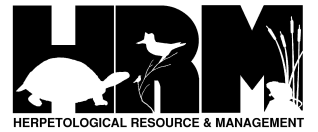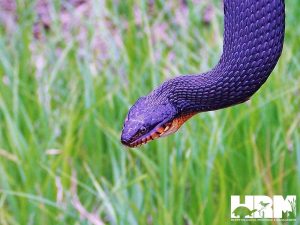Copper-bellied Water Snake
Overview:
Scientific Name: Nerodia erythrogaster neglecta
Size: 26.4 – 56” (adult total length)
Status: In decline throughout the majority of its range. In Michigan, this species is very rare and restricted to a few isolated populations.
Michigan State Status: Endangered;
MDNR Wildlife Action Plan Status: Species of Greatest Conservation Need
Habitat:
Inhabit shrub swamps, ponds, lakes, oxbow sloughs, fens, and slow-moving streams, usually those near mature woodlands but sometimes in more open areas. In spring will move into edges of shallow ponds and can be found basking on the shoreline.
Adult Coloration:
Solid black, gray, or dark brown, occasionally with a faint blotched pattern. Labial scales (along the mouth) are orangish or reddish edged with darker pigment, and throat and chin are white to orange. Belly is solid and ranges from pale orange to red or copper. Ventral (belly) scales often have a dark border that is more prominent toward the tail.
Adult Characteristics:
Large water snake with keeled scales and usually a divided anal plate (about 10% have a complete anal plate). Males are usually smaller than females and have longer tails.
Juvenile Characteristics:
Newborns range from 8.3 – 10.6” in length. Both babies and juveniles have dark blotches on a reddish or grayish brown background. Large blotches on the back alternate with smaller ones down the sides, and may fuse into crossbands toward the head. In juveniles that belly is paler, from light yellow or orange to pink.
Scale Count:
19-23 scale rows at midbody
Species Confused With:
Northern Water Snakes have rows of half-moons on the belly and have a more pronounced blotched pattern on the back and sides (when dry, may look uniformly dark, but when wet usually the pattern is apparent). Kirtland’s Snakes and Queen Snakes also have markings on the belly (spots or stripes, respectively). The Northern Red-Bellied Snake is considerably smaller (does not usually grow larger than 12”) and has 15 scale rows at midbody.
References:
- Amphibians and Reptiles of the Great Lakes Region by Jim Harding
- Harding, J.H. and J.A. Holman. 2006. Michigan Snakes. MSU Extension Ext. Bulletin E-2000,74 pp. [revised].
- Ruthven, A. G., H. B. T. Gaige, et al. 1912. The herpetology of Michigan, by Alexander B. Ruthven. Crystal Thompson and Helen Thompson; Memoranda towards a bibliography of the archaeology of Michigan, by Harlan I. Smith; prepared under the direction of Alexander G. Ruthven. Lansing, Mich., Wynkoop Hallenbeck Crawford, State Printers.
- Holman, J. A. 2012. The Amphibians and Reptiles of Michigan: A Quaternary and Recent Faunal Adventure. Detroit, Mich., Wayne State University Press.
- Conant, R., and Collins, J. T. 1998. Reptiles and Amphibians: Eastern, Central North America. Houghton Mifflin Harcourt Press.

